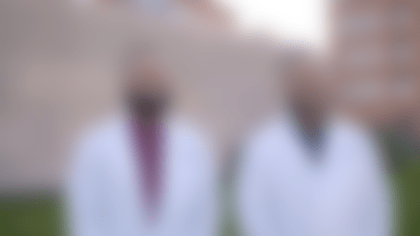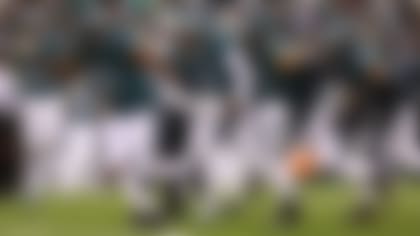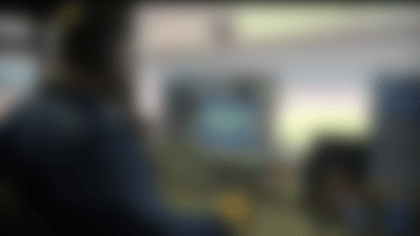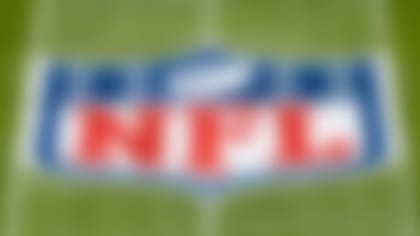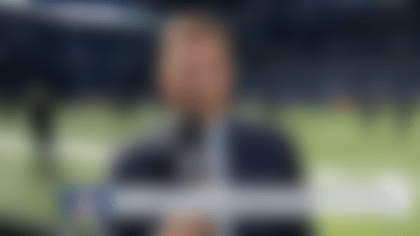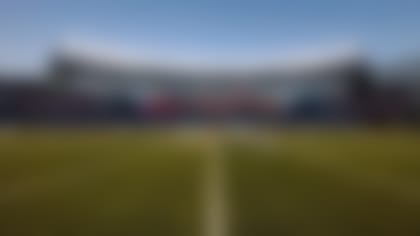Moderated by American Orthopaedic Society for Sports Medicine (AOSSM) President and Steelers Head Orthopaedic Surgeon Dr. James Bradley
July 9, 2020
James P. Bradley MD: Good evening, friends, as Jim would say. We want to thank you all for joining us — we know there are a lot of people from around the world here. I am Jim Bradley from the University of Pittsburgh, and I have the pleasure to have the Chief Medical Officer for the NFL, Allen Sills, and obviously, the Commissioner of the NFL, Roger Goodell, who so kindly lent us some of their time tonight. We're going to start this fireside chat off with the commissioner.
So, commissioner, let's start with some current events. COVID-19 pandemic, the league has been working with medical experts to develop protocols that offer a sound basis for bringing players back to facilities and, down the line, back to the field. Can you tell us what the league is doing to keep their players and staff safe?
NFL Commissioner Roger Goodell: Well, Jim, it is great to be with you tonight. I give a lot of credit to Allen for his leadership in putting together a task force of experts, of not only all our medical doctors and professionals across the league, but also pulling in outside experts that have really been helpful to us in thinking through the challenges and how to work through those solutions, also working very closely with the NFLPA, which is a critical component of this. And as you know better than I do, there is not always unanimity in some of the views on how to address some of the challenges, but we clearly have worked to a very strong consensus and I think we have made the decisions that are in the best interests of our players and our coaches and all personnel that are going to be involved with the game. And then also, another big challenge for us is how we keep our fans safe. For those that will be attending in the stadiums this year, we obviously take that responsibility very seriously. It has really been a very collaborative effort and an effort that we have relied on great experts.
Bradley: Allen, do you have anything to add?
Allen K. Sills, MD: I would just say, we have been working on this literally since things shut down in March. There is still a tremendous amount of work to do. We know that all these protocols are going to continue to evolve. We are also communicating with other sports leagues; not only North American professional leagues, but leagues around the world. I regularly talk to our colleagues around the world to see what they are learning as they try to go back to sport.
But, Jim, I think this is important not just for the NFL or for professional sports — not even for sports at all levels. I think what we are trying to do—which is to find a way to mitigate risk and to coexist with this virus – this is really key information for schools, for businesses, for all segments of society. I think we have a unique opportunity but also a responsibility to use the platform and resources of the NFL to really study and learn and to take that knowledge and apply it for the benefit of the other segments of the society. That is what we plan to do. We have been working very closely with public health authorities, we've been in touch with the CDC, the White House task force, and we will continue to share our data and our findings with all of those organizations and with the medical community at large.
Bradley: Well, you know, the NFL is usually the template for professional sports, whether you, really, like it or not. But you're the leaders, so everybody is looking to you. Can you just touch on the amount of testing that is going to be done? Just to the players and staff?
Sills: Yes, so that is something that we are still working out, Jim. We're still putting the final touches on that process. But we will be doing very frequent testing, what we would consider "surveillance testing," which means we are trying to test everyone – not just players, but players, coaches, support staff, medical staff, everyone who is in what we call the 'team ecosystem.' So, that means everybody that is going to be together in and around the field and the training facility, they are all going to share the same risk and they will all be part of that testing protocol.
It is also important to realize we are never going to test our way to safety here. And what I mean by that is: testing is important, we think it is vital, but it is one component. As Dr. Mayer from the Players Association likes to say, it is a link in the chain, so we still have to be consistent with our use of PPE, with physical distancing where it is appropriate, with good hand hygiene, screening, keeping people away that are sick, quickly isolating anybody who identifies. All of those other principles are going to be equally important as testing is. And I think that is a really important message.
Sometimes people think "well, hey, we test everybody, we know that everybody is negative, so we can go do football as usual.' That is definitely the wrong message and that is something we have to make sure that we consistently communicate — that testing is really not the sole answer here. It's part of a linked chain, and if we don't do a good job with all those other features, then we won't succeed.
Bradley: The next question I have is: COVID has brought us with it a lot of anxiety and stress-inducing uncertainty for everyone. For the players who rely on a regimented schedule, the structure to be successful, there are many new challenges, like staying fit without access to facilities, getting to know new coaching staff through virtual platforms, and uncertainty about the process and timelines. How is the League, Commissioner, going to approach those challenges for those players?
Goodell: Well, you know Doc, that was one of the things we started on back in March. Immediately we started our new year and we had to alter the way we evaluated draft-eligible players. We didn't allow them to travel, we didn't allow our teams to travel to them, and that was for the safety of all personnel. We did the same with our NFL free agents. And then of course we had to adapt and show how we were going to do our offseason, how we were going to do that virtually. And we gave equipment and we worked with players to make that they had the equipment needed to be able to continue to stay physically healthy and prepare for the season as best as they could.
And the virtual actually worked quite well. I've had a lot of players that I have discussed this with, and coaches who feel that, actually, there are elements of that they want to use even going forward that I think is going to change the way we train our athletes and so that was very positive. Of course, we had to adapt tremendously in the Draft where we had to do that entirely virtually.
And, you know, what I think we have proven is that we can do it safely, we can do it without any exceptions from any of the public health officials. We really focused on making sure we executed properly. And we are taking the same approach here to training camp and to the season and making sure we're doing all of the protocols without exception and making sure that we follow the medical advice of the public health officials that we are working so closely with. I think really that is the approach we've taken right from the beginning: do things with safety first. That is the number one thing for us. The health and safety of our players, all of our personnel, and of course our fans.
Sills: And I think Jim, just to piggyback on that, you know this is about something the Commissioner said: this is about reinventing and reimaging all of the things that we normally do. We can't go about business as usual, whether we're talking about how we train, how we prepare, how we stage our games, all of those things we are having to look at through a new lens, which is basically this lens of 'how do we mitigate risk?'
And I think one of our athletic trainers said it best, I know we have number of athletic trainers joining us tonight, I think this is incredibly wise: Reggie Scott said, "it's not going to feel normal because it's going to be normal." And I think that is important for us all to realize, there are going to be changes around how we do things and, as the Commissioner said, some of those may be permanent changes because we'll find better ways of doing things. But we all have to have that mindset of really being flexible and adaptable and thinking about how we can do every part of our operation to mitigate risk.
Bradley: Isn't it going to be very fluid, too — you're going to have to change on the fly, you're going to have to, based on what the virus does and what we get, whether we get a vaccine, whether we get antibody testing that does really well. So, I've got to commend you guys: that's going to be really hard, I think.
Goodell: Doc, to that point, one of our philosophies is really to not to try and anticipate what the environment is going to be three months from now. One of the things we've learned here is that it changes very quickly, for the better and for the worse. So for us we had to be prepared for almost every alternative and to be able to work through that. And don't make assumptions. Because you make an assumption that may not be correct, all of you all your plans go away. So what we have really focused on here is: make sure we are being thoughtful, make sure we are getting the right expertise and preparing for every alternative we possibly can and don't make that assumption that everything is going to be better in September, it may not be. But, we're going to be ready for it.
Bradley: Thank you, Commissioner. More broadly, the NFL has made some big commitments the last few years to advance player health and safety. Can you give us a sense of the progress that has been made over that time? Because I have been a part of that it's just been amazing.
Goodell: Well, Doc, I credit all of the medical professionals. We couldn't have done it without them. There have been dramatic changes. I became commissioner in 2006. I think one of the first things that we did which, I believe, has been the underpinning of our success, which is to get better data. We work to get the right kind of data from our injuries. And so we are using that now to not only formulate policy changes and rule changes, but also to evaluate, "have they been effective? Have they done what we expected them to do?" And so that really to me has been one of the big issues.
The second is really looking at policy changes that not only have addressed the specific issue like bringing in third party neutral physicians on concussions, the injury review system, some of those have led to changes in areas we didn't anticipate. Like the injury review system was specifically designed to have another eye to watch to see if a player was in any kind of stress and may have suffered a head trauma of some type. Well, it has turned out to be a very effective, and, well, your audience tonight knows it better than I do, to look at the mechanism of injury and to help in diagnosing an injury. So I think what we have been able to do is use our technology to help us be better at your profession which is medicine and helping keep our players safe and get them healthy.
The last thing I would say which is incredibly important is we have gone through a tremendous cultural change. You may remember, but 12 years ago, the general public was saying, "a player will never raise their hand when they have a concussion" or, "players won't tell on other players" or, "officials won't be able to identify." All of that is not true, and we have proven that. Our players are raising their hands, others are demonstrating to medical professionals to say, "this player may not be right, please check him." And I think we have gotten to a place where our culture has significantly changed and safety of everybody – everybody is contributing to that. I think that is what I am most proud of.
Bradley: Well, Commissioner, you are absolutely right – the players are buying into that. You know it and I know it. It has changed completely, because this is my 29th year and I have seen this thing go by.
Allen, I just want you to touch on one thing: talk to us about the medical advisory committee that helps the commissioner make decisions on footwear and helmets and all that, just touch on that a little bit. I don't think people realize the amount of work that goes into it.
Sills: As you mentioned, Jim, and as the Commissioner mentioned, we gather a tremendous amount of injury data but we don't just stop there. We take that injury data and we marry it with all the video we have. We have bioengineers and biomechanists that look at that. We really bring to the Commissioner, to the ownership, to our rules committee, solid, evidence-based recommendations about ways we can make the game safer. We are all focused around injury reduction. We don't accept the idea that football cannot be made safer. I think one of the things that the Commissioner has said repeatedly is: the game can be entertaining and safer at the same time.
There is a really a regular and robust engagement between the medical side and the "football" side, where we bring that data in and say, "here is what we are seeing, here is what we are observing, here is what our engineers feel like are the mechanisms that are contributing to injury, how can we maybe change that." And then there is a very robust dialogue between not only the rules makers but the coaches themselves.
I'll tell you, two seasons ago, we identified some things on the kickoff play that we thought were contributing to injuries, and all of the special teams coaches in the league got together and said, "based on what you are telling us, docs, here is how we think we can make that play safer." And we came up with a set of rules and changes. That is a tremendous collaboration. And as both of you said, that probably wouldn't have happened 15-20 years ago. But that is where we are today and now, you know Jim, when are rules committee meets, the first thing they want to hear is from the medical side. They say, "bring us the data, tell us what the numbers showed last year, what are you seeing from that?"
And that is the positive cultural change that the Commissioner spoke about that we are going to keep driving towards because we think there is no finish line for health and safety, so we know we have to keep on doing work in this area.
Bradley: So Commissioner, as a team doctor, I know my work has been improved dramatically by this new cutting edge technology that we see to diagnose and treat injuries. What types of technology used on gameday would have been unthinkable 20 years ago? What are we doing on gameday now? I know, but I don't think the audience understands the kind of work and technology that goes into a gameday in the NFL.
Goodell: Well doc, just to that point, I think we have 32 medical professionals on the field every weekend. I would venture a guess that 10 or 12 years ago it was probably half that number. But I think it is not only the medical professionals, but it is also the technology. To your point, the eye in the sky where we actually have people watching video and watching what is happening and can share it with medical professionals on the sidelines. We have protocols for identifying and diagnosing injuries that are critical to us. We have a third neutral doctor that is there to assist and give another opinion which I don't think— I know when it was first raised, there was quite a bit of resistance to that. But I think there has been a great acceptance to that. I think the changes that have happened in our game really have led us to where our NFL players are getting the best medical care of anybody in the world. And I really believe that and that's a result, frankly, of the changes that we've made and the support that we've given, but really the medical professionals themselves.
Bradley: So Allen, just touch a little on the video-replay thing, remember we were all looking at the screen, and all of a sudden, what did you guys do, you changed that. People don't know, well, you can talk about that.
Sills: Yes, Jim, as you know, and for me being on the sidelines for almost thirty years now, no matter how close you are to the field, you don't see everything that is out there. So we found the use of video to simply be essential. We do have, as the Commissioner mentioned, two athletic trainer spotters stationed upstairs. There is also an unaffiliated neuro-specialist upstairs. And those three individuals with two technicians supporting them are doing nothing but watching video and checking the field, and checking the replays, snipping out pieces of that video and sending it to the sideline. And then there is a dialogue between docs like you on the sideline and those folks.
Again, this is all centered around the idea of: how can we do the best job we can together? It is a team effort. We realize that no one person can possibly see the whole field, and so they are watching not only the field, but the players on the bench, players, how they come on and off. And now we see game officials get involved with that.
One of the things I do every summer is I go and teach our game officials signs and symptoms of certain injuries, we're not trying to turn them into doctors, but what we want them to do is to know if they see certain things on the field, they may be the only person on the field who sees that. Let's get that player over, and let's go back and pull that video. So that is all happening in real time and those videos get a tremendous amount of analysis in the week that follows, everybody goes back and looks at that. And, as I mentioned before, we then feed that into our injury evidence platform and look at trends across injuries to see how rules changes or style of play may impact that. It is no exaggeration to say we have taken something that is a huge asset of ours, video, and put it fully into all aspects of our medical operations.
Bradley: So in short: my player gets hurt, I look at the video in slow motion and go to the exact play, and I can tell the mechanism of the injury right there and know almost how bad it is and I can almost predict the injury beforehand. We never had that before – and it's instantaneous, correct?
Sills: Yes. It is on every sideline, it is uniform across all stadiums. And, again, it is shared among all the different physicians. And, as the Commissioner mentioned, it is not just concussions — it is orthopedic injuries, or any injury, and the spotters and those docs upstairs are working with both sidelines. Again, there is a tremendous, collaborative team effort. It is much like a trauma room at a hospital or at an operating room. Everybody has a role to play and everybody is working together as a team to create the safest possible environment for the player.
Goodell: If I could add just one thing to that – the other thing that has been really valuable to us is partnerships with companies and firms that bring incredible expertise. I would go back to GE who, probably over ten years ago, helped us with our first head health challenge and put a focus on: "how do we advance science and challenge the community to come up with solutions to very difficult problems?" It advanced to more recently with AWS who are helping us by using machine learning and helping us take all that data that we have and help us try to find solutions with it. Technology never ends for us. We embrace that and it has helped us get better. It has helped us take all the information that we now have – video, data – and really make sure we are doing the best possible job to not only evaluate the problems and the solutions but also: "did we get the right solution? And should we adapt it further?"
I think we have had over fifty rule changes in the last ten or twelve years that have all been designed specifically for safety. And that has taken techniques out of our game that were dangerous to our players – it is countless injuries we may have prevented by that. We will continue that with soft tissue injuries and lower body injuries. We are working with cleat manufacturers and turf – it just doesn't end for us. We have ways in which we can make our game safer and we still haven't been able to get to the point where we feel like, "this is where we feel like we need to be."
Bradley: So, as my friend used to say to me: Technology changes everything. You have to move with technology.
And here is one really close to my heart, this question: There have been changes in player care over the past decade, the head team physician and the head athletic trainer are now working more closely than ever. And I actually think that they run the show, frankly. Is this reflective of an increased importance of athletic trainers in our health care systems?
Sills: Yes. I can speak to that, Jim. I always say this; I have said it publicly many times. To me, athletic trainers are the backbone of sports medicine care. Period. They are the center of the hub and there are many spokes that come off of that. I have to imagine that if we had to pick a most valuable player it would be the athletic trainer. And we've recognized that by how we involved athletic trainers in these processes.
You mentioned earlier the medical committees and the advisory committees. When we started out with our response to COVID, we had seven different sub-committees looking at different areas, a number of those were chaired by athletic trainers, they were the head person in charge of that. That reflects our appreciation for their unique insights, their experience, and the things that they can bring to that, so they are involved in those committees, they are involved in policymaking. They are certainly involved in our injury analytics and surveillance programs. They do so much of that data entry, but then we come back and partner with them and say, "this is what we are seeing, what do you think?"
I can give you one quick example. The Commissioner mentioned lower extremity injuries. We've had a major focus on that. And so we've had a task force lead by several athletic trainers and some sports scientists looking at training loads, taking the data from Catapult and Zebra systems, for example, and looking in training camp at how that affects hamstring injuries and what can we do to reduce those. And it has been athletic trainers that have been the backbone of that and many other programs that we are seeing developed.
It is a really exciting thing for me to see them move from "hey, those are the guys that tape ankles." We've come a long way from that day. Now they are central coordinators of care. They coordinate those 32 medical professionals that the commissioner mentioned and then they are partners with us on the research side in innovation and advancing our knowledge. I am really thrilled to see that, and I am expecting even more as we move forward because now we realize this isn't just like you or I sitting around as doctors, we've got a whole collaborative team who all have something to bring to the table here.
Bradley: Look, my chief medical officer is John Norwig, my trainer, who I have been with for 29 years. it is like a marriage, believe me, there are some arguments involved.
Next question is for either of you: Athletic trainers are moving up in these leadership positions within medical staffs, on teams from college teams on up. Do you think there are going to be more subspecialties like performance and strength. Actually, will the role of athletic trainers increase in what we do increase rather than stay where it is?
Goodell: Allen should answer this question, but I want to endorse what he just answered, and also say from my perspective as Commissioner: The role of the trainer has been incredibly valuable to us – to our efforts the last 12 years to make the game safer. They have played an incredible role. At every stage, they've taken on additional responsibility. There is nothing they are not willing to address. Just go back to that data: there is someone who has to put that data in. That has to be there on a daily basis, registering and making sure that the information that goes into the database is correct. Their role just continues – we keep giving them more, and they keep taking it. I can't find a more committed and dedicated professional group than the trainers. They have been extraordinary at every level.
Bradley: We only have a few minutes left, but I want to get this question out there: This spring the NFL and the NFL Players' Association agreed to a new 10-year collective bargaining agreement. What changes will that bring with regards to health and safety, and what are your goals, Commissioner, for the next 10 years?
Goodell: We spent an awful lot of time on the CBA – It's over 500 pages, so I can't go through it all, but health and safety was a big part of that. It was a big part of how we deal with our retired players – spending over 2 billion dollars in improvements to their pensions. It was coming up with new policies – coming up with working groups to address issues we still think we can improve on. We worked hand-in-glove with our players' association on player safety – it's a critical way to do it. The input we get from our players directly in the union is valuable. That CBA now has to last another 10 years – and it's not that we won't make changes as we go, we made a lot of changes over the last 10 years in our last CBA to make it better – but this agreement is going to live and breathe and evolve in a way that is going to keep health and safety at the forefront.
Bradley: Allen, can you touch on research a little bit – wasn't that in the CBA, too, some of that?
Sills: Yeah, we do joint research together with the Players' Association – we've spent several million dollars over the last five years supporting medical research, and as the Commissioner said, that's going to continue. Again, we feel we have a responsibility to share what we're learning, not only with other levels of football, but with other sports and others partners around the world. So we'll continue to see research be one of the points that we emphasize. We think it's a core mission of ours. And again, we do that collectively with our players association, who are terrific partners in that.
Bradley: Commissioner, is there any other thing that you'd like all our physicians to know – what do we need to know about what the NFL's going to do in the future?
Goodell: I, number one, have tremendous appreciation for our medical professionals. They're the ones that keep improving what we do and improving the safety of our players and all participants, including our fans. I believe that they're key and they're instrumental in that effort. And we're going to continue not to compromise on that. At every opportunity, we engage with our medical professionals, we get advice from them, and frankly, we don't waver off of that. We are consistent with that, we believe that is the right advice. As you know, there is sometimes healthy disagreement, but I believe our medical professionals come together with a consensus that really puts us in a better position. There will not be any compromise for me, and for this league, on keeping player safety and safety of all participants number one as our objective.





